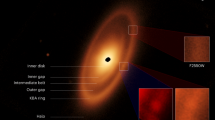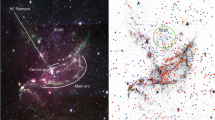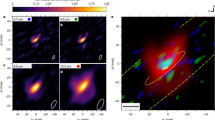Abstract
Indirect detections of massive — presumably Jupiter-like — planets orbiting nearby Sun-like stars have recently been reported1,2. Rocky, Earth-like planets are much more difficult to detect, but clues to their possible existence can nevertheless be obtained from observations of the circumstellar debris disks of dust from which they form. The presence of such disks has been inferred3 from excess far-infrared emission but, with the exception of β Pictoris4, it has proved difficult to image these structures directly as starlight dominates the faint light scattered by the dust5. A more promising approach is to attempt to image the thermal emission from the dust grains at submillimetre wavelengths6,7. Here we present images of such emission around Fomalhaut, β Pictoris and Vega. For each star, dust emission is detected from regions comparable in size to the Sun's Kuiper belt of comets. The total dust mass surrounding each star is only a few lunar masses, so any Earth-like planets present must already have formed. The presence of the central cavity, approximately the size of Neptune's orbit, that we detect in the emission from Fomalhaut may indeed be the signature of such planets.
This is a preview of subscription content, access via your institution
Access options
Subscribe to this journal
Receive 51 print issues and online access
$199.00 per year
only $3.90 per issue
Buy this article
- Purchase on Springer Link
- Instant access to full article PDF
Prices may be subject to local taxes which are calculated during checkout


Similar content being viewed by others
References
Mayor, M. & Queloz, D. A. Jupiter-sized companion to a solar-type star. Nature 378, 355–359 (1995).
Butler, P. & Marcy, G. Detection of extrasolar planets. Annu. Rev. Astron. Astrophys. (in the press).
Aumann, H. H. et al. Discovery of a shell around α Lyrae. Astrophys. J. 278, L23–L27 (1984).
Smith, B. A. & Terrile, R. J. The circumstellar disk around β Pictoris. Science 226, 1421–1424 (1984).
Kalas, P. & Jewitt, D. The detectability of β Pic-like circumstellar disks around nearby main-sequence stars. Astron. J. 111, 1347–1355 (1996).
Zuckerman, B. & Becklin, E. E. Submillimetre studies of main-sequence stars. Astrophys. J. 414, 793–802 (1993).
Chini, R., Krügel, E., Kreysa, E., Shustov, B. & Tutukov, A. Dust disks around Vega-type stars. Astron. Astrophys. 252, 220–228 (1991).
Holland, W. S. et al. in Advanced Technology MMW, Radio and Terahertz Telescopes (ed Phillips, T.) (Proc. SPIE 3357, in the press).
Jenness, T. & Lightfoot, J. F. in Starlink User Manual Vol. 216 (1997).
Backman, D. E. & Paresce, F. in Protostars and Planets III (eds Levy, E. H. & Lunine, J. I.) 1253–1304 (Univ. Arizona Press, Tucson, 1993).
Lester, D., Harvey, P., Smith, B., Colomé, C. & Low, F. The far-IR size of the dust cloud around Fomalhaut. Bull. Am. Astron. Soc. 21, 1085–1086 (1989).
Backman, D. E., Dasgupta, A. & Stencel, R. E. Model of a Kuiper Belt small grain population and resulting far-IR emission. Astrophys. J. 450, L35–L38 (1995).
Harvey, P. M., Smith, B. J., DiFrancesco, J., Colomé, C. & Low, F. J. Far-IR constraints on dust shells around Vega-like stars. Astrophys. J. 471, 973–978 (1996).
Jura, M. et al. Aproto-cometary cloud around HR 4796A? Astrophys. J. (submitted).
Barrado y Navascues, D., Stauffer, J. R., Hartmann, L. & Balachandran, S. C. The age of Gliese 879 and Fomalhaut. Astrophys. J. 475, 313–321 (1997).
Nakano, T. Formation of planets around stars of various masses–II. Stars of two and three solar masses and the origin and evolution of interstallar dust clouds. Mon. Not. R. Astron. Soc. 230, 551–571 (1988).
Armitage, P. J. & Pringle, J. E. Radiation-induced warping of protostellar accretion disks. Astrophys. J. 488, L47–L50 (1997).
Kalas, P. & Jewitt, D. Asymmetries in the β Pictoris disk. Astron. J. 110, 794–804 (1995).
van der Bliek, N. S., Prusti, T. & Waters, L. B. F. M. Vega: smaller dust grains in a larger shell. Astron. Astrophys. 285, 229–232 (1994).
Gulliver, A. F., Hill, G. & Adelman, S. J. Vega: a rapidly rotating pole-on star. Astrophys. J. 429, L81–L84 (1994).
Heap, S. R. et al. Hubble/STIS coronographic imagery of β Pictoris. Bull. Am. Astron. Soc. 29, 1285 (1997).
Maeder, A. & Meynet, G. Tables of evolutionary star models from 0.85 to 120 solar masses, with overshooting and mass loss. Astron. Astrophys. Suppl. 76, 411–425 (1988).
Mannings, V. G. & Emerson, J. P. Dust in disks around T-Tauri stars: Grain growth? Mon. Not. R. Astron. Soc. 267, 361–378 (1994).
Burrows, A. et al. in Brown Dwarfs and Extrasolar Planets (eds Rebolo, R., Martin, E. L. & Zapatero-Osorio, M. R.) 354–369 (ASP conf. ser. Vol. 134, 1998).
Maher, K. A. & Stevenson, D. J. Impact frustration of the origin of life. Nature 331, 612–614 (1988).
Pollack, J. B. et al. Composition and radiative properties of grains in molecular clouds and accretion disks. Astrophys. J. 421, 615–639 (1994).
Freudling, W., Lagrange, A.-M., Vidal-Madjar, A., Ferlet, R. & Forveille, T. Gas around β Pictoris: an upper limit on the HI content. Astron. Astrophys. 301, 231–235 (1995).
Smail, I., Ivison, R. J. & Blain, A. W. Adeep submillimetre survey of lensing clusters: A new window on galaxy formation and evolution. Astrophys. J. 490, L5–L8 (1997).
Jura, M. et al. The fate of the solid matter orbiting HR4796A. Astrophys. J. 445, 45–53 (1995).
Mannings, V. G. Submillimetre observations of Herbig Ae/Be systems. Mon. Not. R. Astron. Soc. 271, 587–600 (1994).
Acknowledgements
The JCMT is operated by the Joint Astronomy Centre, on behalf of the UK Particle Physics and Astronomy Research Council, the Netherlands Organization for Scientific Research, and the Canadian National Research Council. This research was also supported, in part, by NSF and NASA grants to UCLA. We thank E. Becklin for suggestions, and M. Plavec for information regarding stellar models. We also thank P. Kalas and B. A. Smith for sharing unpublished data with us.
Author information
Authors and Affiliations
Corresponding author
Rights and permissions
About this article
Cite this article
Holland, W., Greaves, J., Zuckerman, B. et al. Submillimetre images of dusty debris around nearby stars. Nature 392, 788–791 (1998). https://doi.org/10.1038/33874
Received:
Accepted:
Published:
Issue Date:
DOI: https://doi.org/10.1038/33874
This article is cited by
-
Spatially resolved imaging of the inner Fomalhaut disk using JWST/MIRI
Nature Astronomy (2023)
-
Stellar clustering shapes the architecture of planetary systems
Nature (2020)
-
A brief visit from a red and extremely elongated interstellar asteroid
Nature (2017)
Comments
By submitting a comment you agree to abide by our Terms and Community Guidelines. If you find something abusive or that does not comply with our terms or guidelines please flag it as inappropriate.



